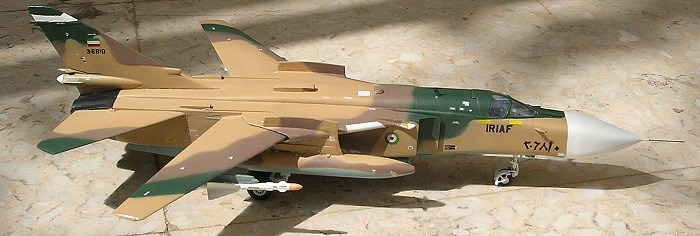
Italeri/Dragon 1/72 Su-24MK 'Fencer D'
| KIT #: | ? |
| PRICE: | Approx $15.00 |
| DECALS: | See review |
| REVIEWER: | Carmel J. Attard |
| NOTES: | Modified from original |

| HISTORY |
The Su-24 NATO Fencer is a two-seat variable geometry battlefield reconnaissance and electronic warfare bomber. Designed as an intended aircraft to replace the Il-28 and the Yak-28 attack aircraft, the prototype T-6-1 first flown in June 1967. Developed as a frontal bomber to deliver a wide range of air to air and air to surface missiles for defense suppression, with some hard to get kill potential, had a specially developed long range navigation system and electro-optical weapons system that makes it possible to penetrate hostile airspace at night or adverse weather with great precision and deliver ordnance on far away target.
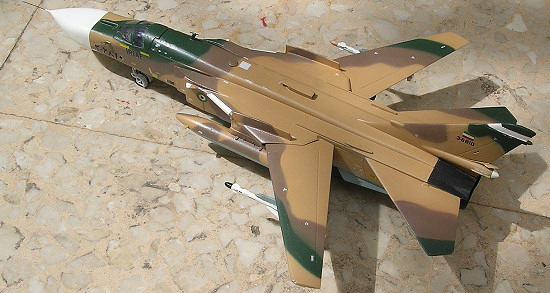 The Su-24 is powered by two Saturn/Lyulka AL-21 F-3A
turbojets, of 16865 Lb st dry and 24690 lb St with after burner and has fixed
engine intakes. It has four internal fuel tanks, capacity 2,570 Imp gallons
which can be supplemented by two 440 Imp gallons external fuel tanks under
fuselage and two 660 Imp gallons tanks under wing pylons. The aircraft is also
equipped with probe-and-drogue flight refueling capacity, including operations
as a buddy tanker. The cockpit has accommodation of a crew of two (pilot and
weapons system officer) side by side on K-36DM ejection seats in a cockpit 5’5”
wide and has a jettisonable canopy, hinged to open upwards and rearwards on two
panels, split at center.
The Su-24 is powered by two Saturn/Lyulka AL-21 F-3A
turbojets, of 16865 Lb st dry and 24690 lb St with after burner and has fixed
engine intakes. It has four internal fuel tanks, capacity 2,570 Imp gallons
which can be supplemented by two 440 Imp gallons external fuel tanks under
fuselage and two 660 Imp gallons tanks under wing pylons. The aircraft is also
equipped with probe-and-drogue flight refueling capacity, including operations
as a buddy tanker. The cockpit has accommodation of a crew of two (pilot and
weapons system officer) side by side on K-36DM ejection seats in a cockpit 5’5”
wide and has a jettisonable canopy, hinged to open upwards and rearwards on two
panels, split at center.
The avionics fitted inside the Fencer consist of two superimposed radar scanners in the nose for nav/attack and terrain clearance and ranging to airborne targets, low ranger/designator under front fuselage, SPO 15 radar warning receivers on side of engine air intakes and tail fin. It also carries a Geram-F active jamming system and integrated defensive aids suite. Armament of the Su-24M are carried on nine pylons under the fuselage and wing root gloves and outer. For guided and unguided air-to-surface weapons including TN-1000 and TN-1200 nuclear weapons, up to four TV or laser-guided bombs, missiles as Kh-23, Kh-25, Kh-58, among others, rockets of 57mm t- 370mm Caliber, bombs, 23mm gun pods or external fuel tanks. Two R-60 (AA-8 Aphid) air-to-air missiles and other varieties can be carried for self-defense. There is one G Sh-6-23mm six-barrel 23mm Gatling Gun inside fairing on starboard side of fuselage undersurface,. Fairing for recording camera on other side. It has an empty weight of 41,885 Lb. The export version Sukhoi MK has a maximum level speed of Mach 1.35 at height and Mach 1.08 at sea level. It has a service ceiling of 57,000 Ft and a maximum rate of climb of 27,000 Ft per minute. The Su-24 MK also known as Fencer D for export has downgraded avionics and developed for Arabian nations. Among the countries that received the export version are 14 for Iran, which also received 18 ex-Iraqi AF ones; Libya has 15 and Syria 20. Algeria is the last one to receive the type and 6 have already been delivered.
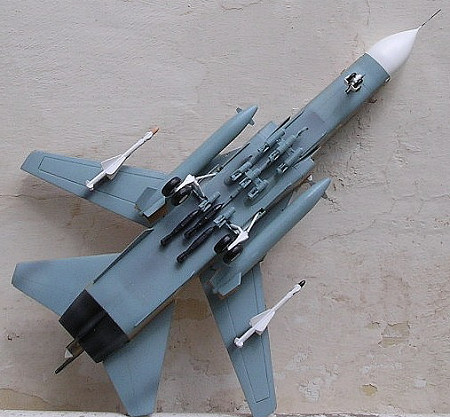 Interesting about the Iranian Sukhois, 12 of which were
delivered initially by the Soviet Union and 16-18 acquired from Saddam’s regime
is that these were organized into one squadron and forms the backbone of the
Islamic state that now is known to have 24 Fencers in operational status. If
Iran acquires a nuclear weapon, the Fencers could be used as the interim
delivery capacity, pending perfection of an adequate ballistic long-range
missile. Iran may indigenously produce enough fissile material for a nuclear
weapon by late this decade. The medium range Shahab 3 missile tested in July
22nd derived from N Korean model, the Nandong has a range of 730 miles and a
payload of 1500 lb single warhead. All the Su-24 delivered to the Islamic
Republic of Iran were modified with in-flight refueling probe to receive fuel
from KC-707 3J9C tankers equipped with Beech 1600 refueling pods, carried under
wing tips
Interesting about the Iranian Sukhois, 12 of which were
delivered initially by the Soviet Union and 16-18 acquired from Saddam’s regime
is that these were organized into one squadron and forms the backbone of the
Islamic state that now is known to have 24 Fencers in operational status. If
Iran acquires a nuclear weapon, the Fencers could be used as the interim
delivery capacity, pending perfection of an adequate ballistic long-range
missile. Iran may indigenously produce enough fissile material for a nuclear
weapon by late this decade. The medium range Shahab 3 missile tested in July
22nd derived from N Korean model, the Nandong has a range of 730 miles and a
payload of 1500 lb single warhead. All the Su-24 delivered to the Islamic
Republic of Iran were modified with in-flight refueling probe to receive fuel
from KC-707 3J9C tankers equipped with Beech 1600 refueling pods, carried under
wing tips
The Su-24 is the most numerous bombers still in Russian service with over 500 still operating and this is a clear proof of its fundamental success as a design. The slow progress in the development of a replacement new design may also attribute to its success although this may be so due to the economic limitations imposed on the post Soviet, Russian Air Force. Like all other combat aircraft that goes to war, the Su-24 also has its share of losses. Islamic Mujahedin in Afghanistan and Chechnya have shot down several with not much effort. Sukhoi-24s operated alongside Tupoleve Tu-16s in Afghanistan way back in April 1984 in support of the Russian 40th Army and Afghanistan armed forces. They delivered their bomb loads from an unfavorable 18,000 ft altitude, as low altitude operations over mountainous terrain held by rebel forces were not attempted. This was due to the threat of hand held short-range air defense missile system as Strela, Stinger and Redeye missiles made available to the rebels by US backed armed dealers. The Su-24 had little defense against these missiles. Flying the Su-24s at medium altitude rendered their advanced sighting/ navigating systems practically useless. Still the Su-24 continues to be upgraded with the latest state of the art avionics and renders it an effective weapon delivery system serving with the Russian forces and several Islamic Arab countries these days.
| THE KIT |
The kit contains a set of 8 sprues
in light grey plastic, bagged in separate plastic bags and another two sprues in
clear plastic for canopy parts, landing lights etc, 11pieces in all including a
separate cockpit canopy split at center to allow it shown in open position if so
desired. Surface detail on the main parts may be on the lacking side but quality
of the plastic is high with panel lines detail impressed in the plastic. Fold
out instructions of A5 size show black and white photo of the model and a brief
history in four languages. There are ten steps of construction to follow
starting with the cockpit that features seats, control column, instrument
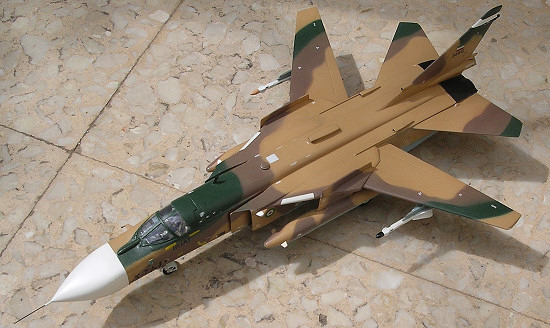 panel,
and side pilot bulkheads. I found he fit of cockpit parts quite acceptable
though care is needed. The fuselage comes into three major broken down sections
and provision is made for a simple mechanism to make the swing in any position.
Putty filler was needed for the forward fuselage to obtain a flush fit. The rear
fuselage section also needed some attention to obtain a smooth continuous flush
to go with the rest of the fuselage. Fitting the jet exhaust outlets needed some
care as well in order to fit these symmetrically.
panel,
and side pilot bulkheads. I found he fit of cockpit parts quite acceptable
though care is needed. The fuselage comes into three major broken down sections
and provision is made for a simple mechanism to make the swing in any position.
Putty filler was needed for the forward fuselage to obtain a flush fit. The rear
fuselage section also needed some attention to obtain a smooth continuous flush
to go with the rest of the fuselage. Fitting the jet exhaust outlets needed some
care as well in order to fit these symmetrically.
Two large fuel tanks are fitted to the inner pylons, which are placed on the static part of the wing, but there is a pair of pylons that fit on the moving outer part of the wing which once the wings swivel these remain static instead of swiveling correspondingly. So for the sake of authenticity one will have to decide either leaving the wings to swivel and without fitting the outer pylons or else fix the wings in one position and fit the pylons in place and parallel to the fuselage centerline axis. In selecting the latter option one can fix stores to the pylons, missiles or bombs.
| CONSTRUCTION |
My desire
was to build the Su-24MK Fencer D, the export version, which to me appeared to
have a more streamlined design being longer at the forward fuselage. This meant
that at a scale of 1/72 I had to lengthen the fuselage ahead of the cockpit by
exactly ˝ inches besides other changes that will be mentioned as we go along. So
I built a slot that fitted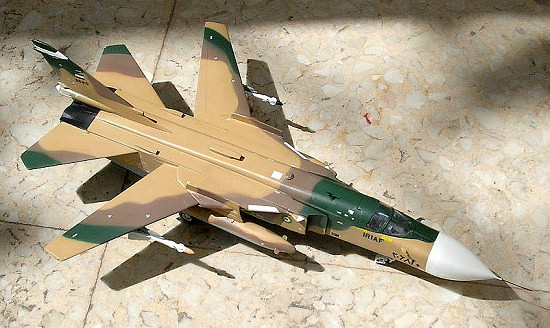 in between the radome and the fuselage. This
consisted of a box like construction of same width and height as the fuselage
section ahead of cockpit and ˝” long. This was then inserted, faired with putty,
sanded to the same contours as the rest of the fuselage and the whole assembly
takes a slight droop towards the front nose radome. This operation took less
than an hour to construct and fit in place with adequate putty added to bring a
smooth finish in the end.
in between the radome and the fuselage. This
consisted of a box like construction of same width and height as the fuselage
section ahead of cockpit and ˝” long. This was then inserted, faired with putty,
sanded to the same contours as the rest of the fuselage and the whole assembly
takes a slight droop towards the front nose radome. This operation took less
than an hour to construct and fit in place with adequate putty added to bring a
smooth finish in the end.
The nose probe antenna was replaced with a longer probe, and a refueling probe made from stretched sprue was added to forward of the cockpit. This can be fixed in the raised position with careful study to photos of the aircraft in this configuration. Building the MK version as in service with the IRIAF and Arab air forces also needed the addition of fairly large wing fences that were absent on the short nose ‘C’ version. These corresponded with the same position as the inner under wing pylons and in fact join together at the front. Unlike the wing fences carried by the Russian Fencer M the ‘pylon to fence’ assembly had a square front instead of a rounded corner and this made the Su-24 more easily recognizable from its Russian counterpart. This was made from plastic card of equal thickness as the pylon and fitted in place accordingly. The joining area between the pylon and the fence was built up with putty and smoothened down to bring it into one piece. Other external detail in form of aerials and antennae were added at this stage.
| COLORS & MARKINGS |
The undercarriage that comes with the kit looks convincing though somewhat basic and needed sanding of the centerline seams of parts to improve the matter. The kit is finished in the three tone of sand, dark earth and green upper surface camouflage with Light blue FS 35526 underside and nose cone white FS27875.
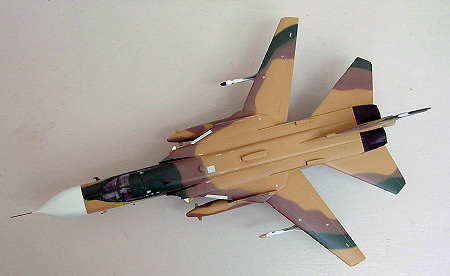 As for
the decals, I did not need the stars since I replaced these with the Iranian
roundels. I have used all the stencil decals, which at some time seemed to be
fairly thick as in fact the decal that fits around the oleo could not take the
small diameter of the leg. I had no problem to fork out the Iranian roundels
from the spares box. The Fencer only carried these on the fuselage intake sides
and none appeared over the wings. I found the smaller roundels that come from an
ESCI, F4 sheet to fit exactly the size I needed. The fin flashes were also the
same size. The Arabic nose decals came from a Super scale decal sheet for the
Su-25 Frogfoot, which contained decals numbers from 1 to 10.The kit was
completed to represents a Su-24MK of the 72nd Tac Ftr. Sq based at
Shiraz. Similar detachments are based at Teheran-Metrabat airbase and an
anti-shipping detachment is based at Chah Buhar. The kit is assembled with a
vast range of armament which includes large bombs type FAB-1500 Mk 46, and small
bombs type FAB-250M-46. Two wing mounted Russian type air-to- air missiles are
mounted under the wings.
As for
the decals, I did not need the stars since I replaced these with the Iranian
roundels. I have used all the stencil decals, which at some time seemed to be
fairly thick as in fact the decal that fits around the oleo could not take the
small diameter of the leg. I had no problem to fork out the Iranian roundels
from the spares box. The Fencer only carried these on the fuselage intake sides
and none appeared over the wings. I found the smaller roundels that come from an
ESCI, F4 sheet to fit exactly the size I needed. The fin flashes were also the
same size. The Arabic nose decals came from a Super scale decal sheet for the
Su-25 Frogfoot, which contained decals numbers from 1 to 10.The kit was
completed to represents a Su-24MK of the 72nd Tac Ftr. Sq based at
Shiraz. Similar detachments are based at Teheran-Metrabat airbase and an
anti-shipping detachment is based at Chah Buhar. The kit is assembled with a
vast range of armament which includes large bombs type FAB-1500 Mk 46, and small
bombs type FAB-250M-46. Two wing mounted Russian type air-to- air missiles are
mounted under the wings.
| CONCLUSIONS |
Overall I found that the Italeri/Dragon kit provided a good basis to produce the version that I desired to make. Making this later export version also helped to enhance the warlike appearance of the scale model, as the short nose version did not quite appealed to me. Still the finished model found its rightful place next to the F5, F14 and the Su-25 also finished in similar Iranian desert schemes as applied to IRIAF aircraft that I built some time before.
April 2006
Copyright ModelingMadness.com. All rights reserved. No reproduction in any form without express permission from the editor.
If you would like your product reviewed fairly and fairly quickly, please contact the editor or see other details in the Note to Contributors.